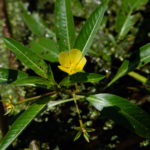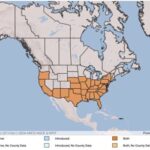Ludwigia peploides
Illustration: USDA-NRCS PLANTS Database / Britton, N.L., and A. Brown. 1913. An illustrated flora of the northern United States, Canada and the British Possessions. 3 vols. Charles Scribner’s Sons, New York. Vol. 2: 589.
What is Floating Primrose?
Physical Characteristics
Leaves:
- Oval-shaped
- 0.39-3.5 inches long
- 0.2-1.5 inches wide
- Leaf stalk 0.2-1.5 inches long
Flowers:
Fruit:
- Dry
- 0.39-1.5 inches long
- 0.13-0.16 inches thick
Seeds:
- About 0.05 inches long
- Firmly planted in a cube in the woody part of the fruit
Stem:
- Branching upward
- Up to 2 feet long
Where Does it Grow?
USDA, NRCS. The PLANTS Database (http://plants.usda.gov). National Plant Data Team, Greensboro, NC 27401-4901 USA.
Floating primrose can be found in ponds and streams; they float as mats on the surface of the water.
Pros and Cons of Floating Primrose
Ducks and other waterfowl will consume the seeds of water primrose. Submerged portions of all aquatic plants provide habitats for many micro and macro invertebrates. These invertebrates in turn are used as food by fish and other wildlife species (e.g. amphibians, reptiles, ducks, etc). After aquatic plants die, their decomposition by bacteria and fungi provides food (called “detritus”) for many aquatic invertebrates.




